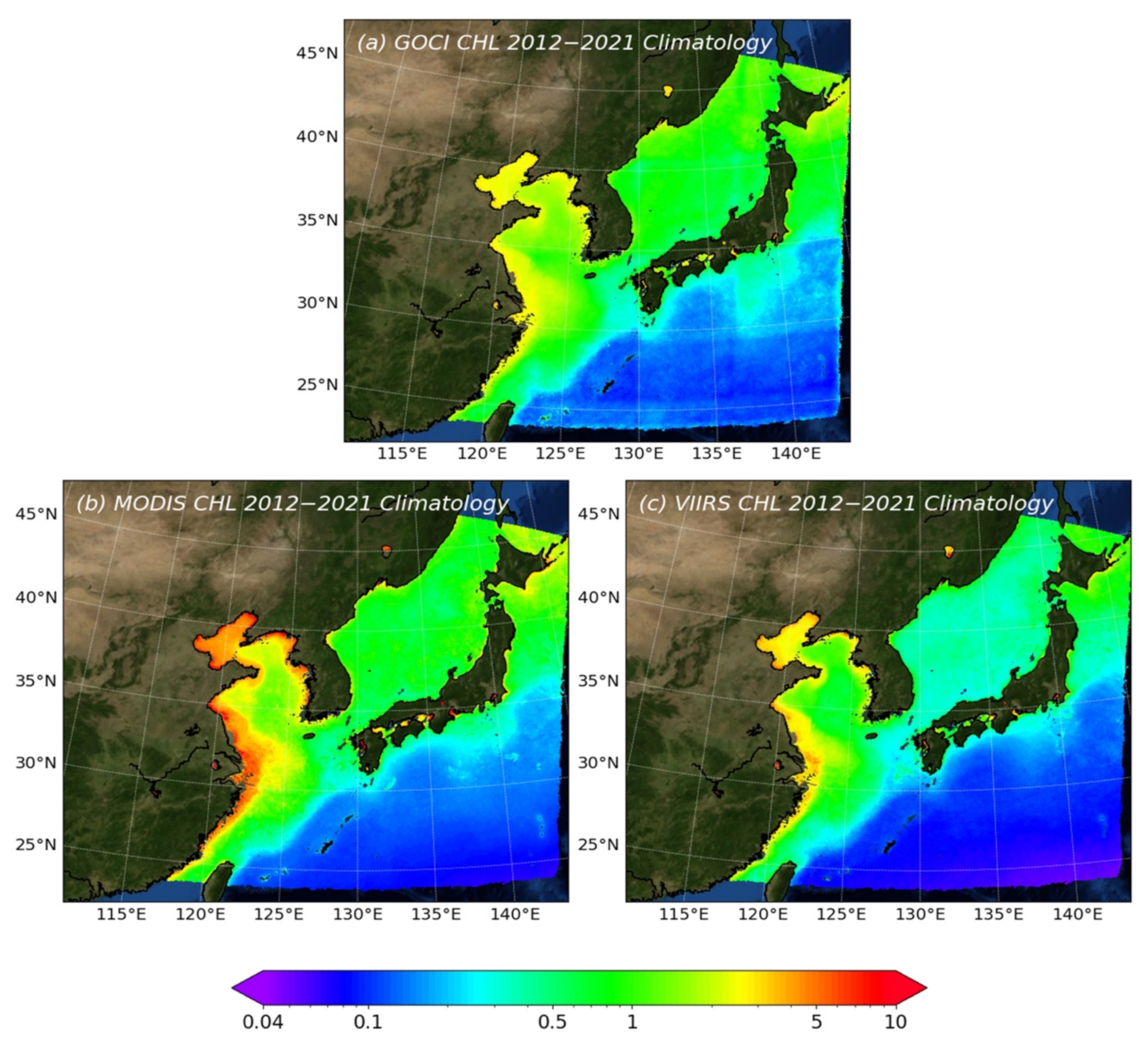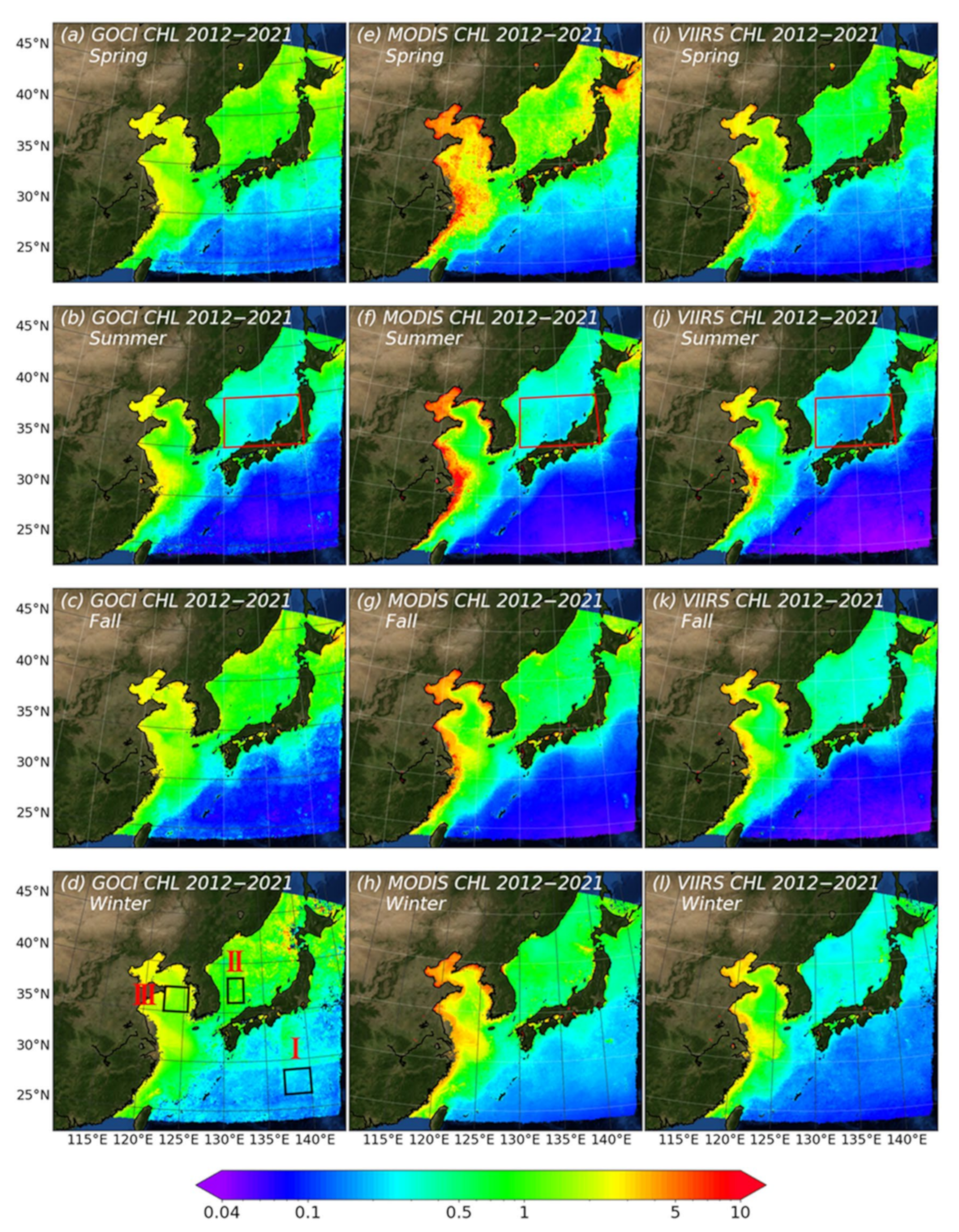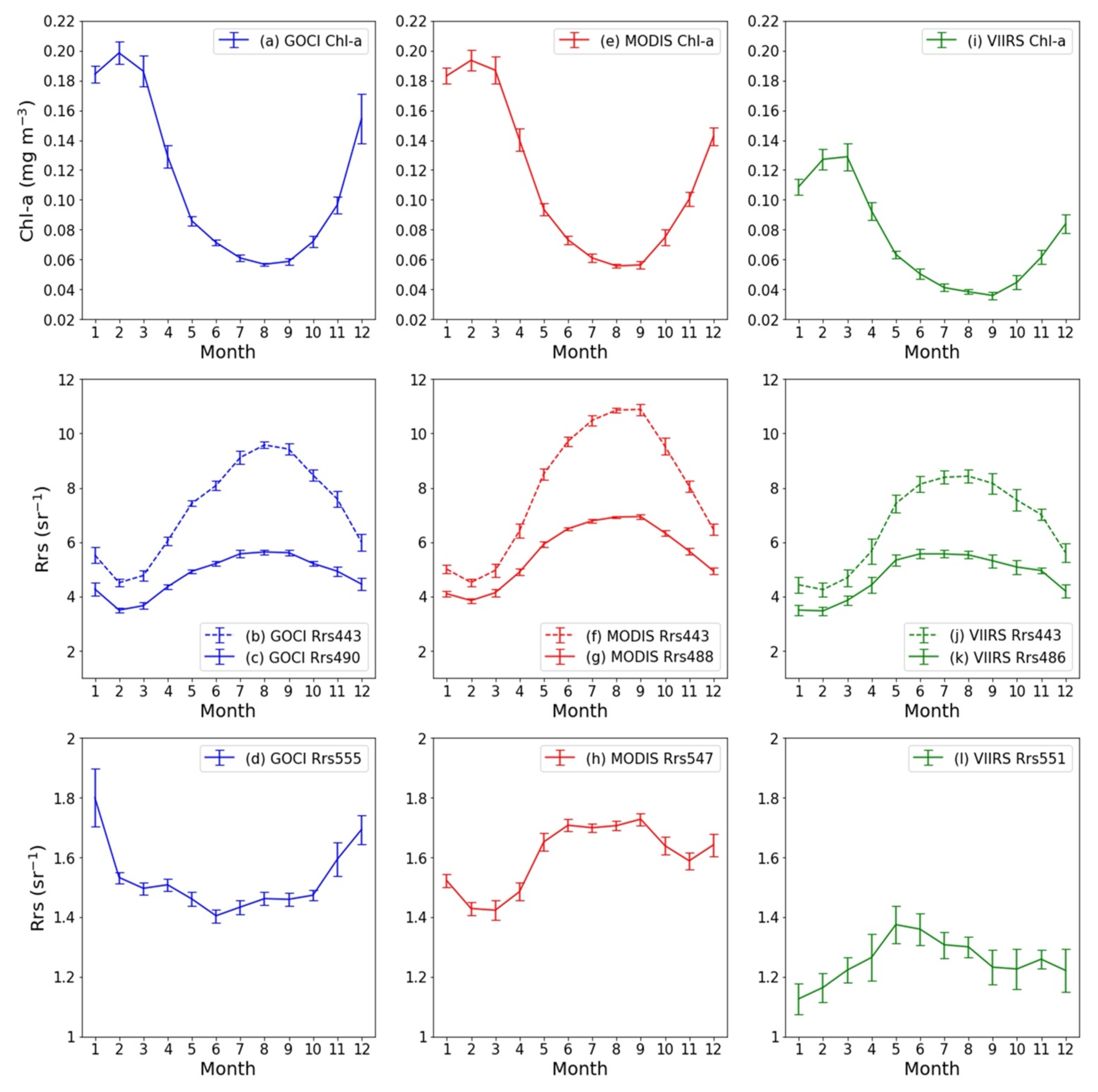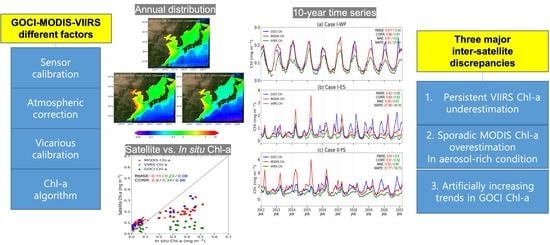Decadal Measurements of the First Geostationary Ocean Color Satellite (GOCI) Compared with MODIS and VIIRS Data
Abstract
:1. Introduction
2. Data and Methods
2.1. Data
2.2. Binned Data Products
2.3. Statistical Metrics for Data Inter-Comparison
3. Results
3.1. Scene-by-Scene Comparison among the Three Satellites
3.2. Climatological Distribution of Phytoplankton Biomass
3.3. Seasonal Variation
3.4. Two-Dimensional Frequency Distribution of Chlorophyll-a and Inter-Comparison Statistics
3.5. Inter-Comparison of Chl-a Time Series
4. Discussion
4.1. Multi-Year Time Series of Rrs and Blue to Green Band Ratio
4.2. Inter-Satellite Discrepancy in East Asia’s Dynamic Atmospheric and Ocean Conditions
4.3. Seasonal Cycle of Chl-a and Rrs for Low Biomass Region
5. Summary and Conclusions
Supplementary Materials
Author Contributions
Funding
Informed Consent Statement
Data Availability Statement
Acknowledgments
Conflicts of Interest
References
- Behrenfeld, M.J.; Randerson, J.T.; McClain, C.R.; Feldman, G.C.; Los, S.O.; Tucker, C.J.; Falkowski, P.G.; Field, C.B.; Frouin, R.; Esaias, W.E.; et al. Biospheric Primary Production During an ENSO Transition. Science 2001, 291, 2594–2597. [Google Scholar] [CrossRef] [Green Version]
- Field, C.B.; Behrenfeld, M.J.; Randerson, J.T.; Falkowski, P. Primary production of the biosphere: Integrating terrestrial and oceanic components. Science 1998, 281, 237–240. [Google Scholar] [CrossRef] [Green Version]
- Behrenfeld, M.J.; O’Malley, R.T.; Siegel, D.A.; McClain, C.R.; Sarmiento, J.L.; Feldman, G.C.; Milligan, A.J.; Falkowski, P.G.; Letelier, R.M.; Boss, E.S. Climate-driven trends in contemporary ocean productivity. Nature 2006, 444, 752–755. [Google Scholar] [CrossRef]
- Dutkiewicz, S.; Hickman, A.E.; Jahn, O.; Henson, S.; Beaulieu, C.; Monier, E. Ocean colour signature of climate change. Nat. Commun. 2019, 10, 578. [Google Scholar] [CrossRef] [PubMed] [Green Version]
- Franz, B.A.; Bailey, S.W.; Meister, G.; Werdell, P.J. Quality and consistency of the NASA ocean color data record. In Proceedings of the Ocean Optics XXI, Glasgow, UK, 8–12 October 2012. [Google Scholar]
- Eplee, R.E.; Meister, G.; Patt, F.S.; Barnes, R.A.; Bailey, S.W.; Franz, B.A.; McClain, C.R. On-orbit calibration of SeaWiFS. Appl. Opt. 2012, 51, 8702–8730. [Google Scholar] [CrossRef] [PubMed]
- Eplee, R.E.; Turpie, K.R.; Meister, G.; Patt, F.S.; Fireman, G.F.; Franz, B.A.; McClain, C.R. A Synthesis of VIIRS Solar and Lunar Calibrations. Earth Obs. Syst. XVIII 2013, 8866, 88661L. [Google Scholar] [CrossRef] [Green Version]
- Franz, B.A.; Bailey, S.W.; Werdell, P.J.; McClain, C.R. Sensor-independent approach to the vicarious calibration of satellite ocean color radiometry. Appl. Opt. 2007, 46, 5068–5082. [Google Scholar] [CrossRef]
- Gordon, H.R.; Wang, M. Retrieval of water-leaving radiance and aerosol optical thickness over the oceans with SeaWiFS: A preliminary algorithm. Appl. Opt. 1994, 33, 443–452. [Google Scholar] [CrossRef]
- Zibordi, G.; Mélin, F.; Berthon, J.F.; Talone, M. In situ autonomous optical radiometry measurements for satellite ocean color validation in the Western Black Sea. Ocean Sci. 2015, 11, 275–286. [Google Scholar] [CrossRef] [Green Version]
- Wang, M.; Gordon, H.R. A simple, moderately accurate, atmospheric correction algorithm for SeaWiFS. Remote Sens. Environ. 1994, 50, 231–239. [Google Scholar] [CrossRef]
- Wang, M.; Son, S.H. VIIRS-derived chlorophyll-a using the ocean color index method. Remote Sens. Environ. 2016, 182, 141–149. [Google Scholar] [CrossRef]
- Brickley, P.J.; Thomas, A.C. Satellite-measured seasonal and inter-annual chlorophyll variability in the Northeast Pacific and Coastal Gulf of Alaska. Deep Sea Res. Part II Top. Stud. Oceanogr. 2004, 51, 229–245. [Google Scholar] [CrossRef]
- Hu, C.; Muller-Karger, F.E.; Taylor, C.; Carder, K.L.; Kelble, C.; Johns, E.; Heil, C.A. Red tide detection and tracing using MODIS fluorescence data: A regional example in SW Florida coastal waters. Remote Sens. Environ. 2005, 97, 311–321. [Google Scholar] [CrossRef]
- Hu, C. A novel ocean color index to detect floating algae in the global oceans. Remote Sens. Environ. 2009, 113, 2118–2129. [Google Scholar] [CrossRef]
- Bisson, K.M.; Boss, E.; Werdell, P.J.; Ibrahim, A.; Frouin, R.; Behrenfeld, M.J. Seasonal bias in global ocean color observations. Appl. Opt. 2021, 60, 6978–6988. [Google Scholar] [CrossRef]
- Hoi, J.-K.; Park, Y.J.; Ahn, J.H.; Lim, H.-S.; Eom, J.; Ryu, J.-H.; Choi, C.; Park, Y.J.; Ahn, J.H.; Lim, H.-S.; et al. GOCI, the world’s first geostationary ocean color observation satellite, for the monitoring of temporal variability in coastal water turbidity. J. Geophys. Res. Ocean. 2012, 117, 9004. [Google Scholar] [CrossRef]
- Noh, J.H.; Kim, W.; Son, S.H.; Ahn, J.H.; Park, Y.J. Remote quantification of Cochlodinium polykrikoides blooms occurring in the East Sea using geostationary ocean color imager (GOCI). Harmful Algae 2018, 73, 129–137. [Google Scholar] [CrossRef] [PubMed]
- Doxaran, D.; Lamquin, N.; Park, Y.J.; Mazeran, C.; Ryu, J.H.; Wang, M.; Poteau, A. Retrieval of the seawater reflectance for suspended solids monitoring in the East China Sea using MODIS, MERIS and GOCI satellite data. Remote Sens. Environ. 2014, 146, 36–48. [Google Scholar] [CrossRef]
- Moon, J.E.; Park, Y.J.; Ryu, J.H.; Choi, J.K.; Ahn, J.H.; Min, J.E.; Son, Y.B.; Lee, S.J.; Han, H.J.; Ahn, Y.H. Initial validation of GOCI water products against in situ data collected around Korean peninsula for 2010–2011. Ocean Sci. J. 2012, 47, 261–277. [Google Scholar] [CrossRef]
- Ahn, J.; Park, Y.; Kim, W.; Lee, B.; Gordon, H.R.; Brown, J.W.; Evans, R.H. Simple aerosol correction technique based on the spectral relationships of the aerosol multiple-scattering reflectances for atmospheric correction over the oceans. Opt. Express 2016, 24, 29659–29669. [Google Scholar] [CrossRef]
- Kim, W.; Moon, J.E.; Park, Y.; Ishizaka, J. Evaluation of chlorophyll retrievals from Geostationary Ocean Color Imager (GOCI) for the North-East Asian region. Remote Sens. Environ. 2016, 184, 482–495. [Google Scholar] [CrossRef]
- Ahmad, Z.; Franz, B.A.; McClain, C.R.; Kwiatkowska, E.J.; Werdell, J.; Shettle, E.P.; Holben, B.N. New aerosol models for the retrieval of aerosol optical thickness and normalized water-leaving radiances from the SeaWiFS and MODIS sensors over coastal regions and open oceans. Appl. Opt. 2010, 49, 5545–5560. [Google Scholar] [CrossRef]
- Kim, W.; Ahn, J.H.; Park, Y.J. Correction of Stray-Light-Driven Interslot Radiometric Discrepancy (ISRD) Present in Radiometric Products of Geostationary Ocean Color Imager (GOCI). IEEE Trans. Geosci. Remote Sens. 2015, 53, 5458–5472. [Google Scholar] [CrossRef]
- Ahn, J.H.; Park, Y.J.; Ryu, J.H.; Lee, B.; Oh, I.S. Development of atmospheric correction algorithm for Geostationary Ocean Color Imager (GOCI). Ocean Sci. J. 2012, 47, 247–259. [Google Scholar] [CrossRef]
- Ahn, J.-H.; Park, Y.-J.; Kim, W.; Lee, B.; Oh, I.S. Vicarious calibration of the Geostationary Ocean Color Imager. Opt. Express 2015, 23, 23236–23258. [Google Scholar] [CrossRef]
- Shettle, E.P.; Fenn, R.W. Models for the Aerosols of the Lower Atmosphere and the Effects of Humidity Variations on Their Optical Properties; Air Force Geophysics Laboratory, Air Force Systems Command, United States Air Force: Montgomery County, OH, USA, 1979. [Google Scholar]
- Bailey, S.W.; Franz, B.A.; Werdell, P.J. Estimation of near-infrared water-leaving reflectance for satellite ocean color data processing. Opt. Express 2010, 18, 7521–7527. [Google Scholar] [CrossRef] [PubMed]
- O’Reilly, J.E.; Maritorena, S.; Mitchell, B.G.; Siegel, D.A.; Carder, K.L.; Garver, S.A.; Kahru, M.; McClain, C. Ocean color chlorophyll algorithms for SeaWiFS. J. Geophys. Res. Ocean. 1998, 103, 24937–24953. [Google Scholar] [CrossRef] [Green Version]
- Hu, C.; Lee, Z.; Franz, B. Chlorophyll aalgorithms for oligotrophic oceans: A novel approach based on three-band reflectance difference. J. Geophys. Res. Ocean. 2012, 117, 1011. [Google Scholar] [CrossRef] [Green Version]
- IOCCG. Guide to the Creation and Use of Ocean-Colour, Level-3, Binned Data Products; Antoine, D., Ed.; Reports of the International Ocean-Colour Coordinating Group, No. 4; International Ocean-Colour Coordinating Group (IOCCG): Dartmouth, NS, Canada, 2004; 88p. [Google Scholar] [CrossRef]
- Kim, S.W.; Saitoh, S.I.; Ishizaka, J.; Isoda, Y.; Kishino, M. Temporal and Spatial Variability of Phytoplankton Pigment Concentrations in the Japan Sea Derived from CZCS Images. J. Oceanogr. 2000, 56, 527–538. [Google Scholar] [CrossRef]
- MIYASHITA, M. Bi-weekly to Seasonal Variability of Satellite-derived Chlorophyll a Distribution: Controlling Factors in the Ocean South of Honshu Island. J. Remote Sens. Soc. Japan 2005, 25, 169–178. [Google Scholar] [CrossRef]
- Moses, W.J.; Gitelson, A.A.; Berdnikov, S.; Povazhnyy, V. Estimation of chlorophyll-a concentration in case II waters using MODIS and MERIS data—successes and challenges. Environ. Res. Lett. 2009, 4, 45005. [Google Scholar] [CrossRef] [Green Version]
- Wu, A.; Mu, Q.; Angal, A.; Xiong, X. Assessment of MODIS and VIIRS calibration consistency for reflective solar bands calibration using vicarious approaches. In Proceedings of the Sensors, Systems, and Next-Generation Satellites XXIV, online, 21–25 September 2020; Volume 11530, p. 1153018. [Google Scholar]
- Choi, M.; Lim, H.; Kim, J.; Lee, S.; Eck, T.T.; Holben, B.B.; Garay, M.J.; Hyer, E.E.; Saide, P.P.; Liu, H. Validation, comparison, and integration of GOCI, AHI, MODIS, MISR, and VIIRS aerosol optical depth over East Asia during the 2016 KORUS-AQ campaign. Atmos. Meas. Tech. 2019, 12, 4619–4641. [Google Scholar] [CrossRef] [Green Version]
- Wang, M.; Gordon, H.R. Calibration of ocean color scanners: How much error is acceptable in the near infrared? Remote Sens. Environ. 2002, 82, 497–504. [Google Scholar] [CrossRef]
- Park, M.-S.; Choi, Y.-S.; Ho, C.-H.; Sui, C.-H.; Park, S.K.; Ahn, M.-H. Regional cloud characteristics over the tropical northwestern Pacific as revealed by Tropical Rainfall Measuring Mission (TRMM) Precipitation Radar and TRMM Microwave Imager. J. Geophys. Res. Atmos. 2007, 112. [Google Scholar] [CrossRef] [Green Version]
- Ahn, J.-H.; Park, Y.-J.; Fukushima, H. Comparison of Aerosol Reflectance Correction Schemes Using Two Near-Infrared Wavelengths for Ocean Color Data Processing. Remote Sens. 2018, 10, 1791. [Google Scholar] [CrossRef] [Green Version]
- Morel, A.; Claustre, H.; Gentili, B. The most oligotrophic subtropical zones of the global ocean: Similarities and differences in terms of chlorophyll and yellow substance. Biogeosciences 2010, 7, 3139–3151. [Google Scholar] [CrossRef] [Green Version]
- Bisson, K.M.; Boss, E.; Westberry, T.K.; Behrenfeld, M.J. Evaluating satellite estimates of particulate backscatter in the global open ocean using autonomous profiling floats. Opt. Express 2019, 27, 30191–30203. [Google Scholar] [CrossRef]
- Wang, T.; Chen, F.; Zhang, S.; Pan, J.; Devlin, A.T.; Ning, H.; Zeng, W. Remote Sensing and Argo Float Observations Reveal Physical Processes Initiating a Winter-Spring Phytoplankton Bloom South of the Kuroshio Current Near Shikoku. Remote Sens. 2020, 12, 4065. [Google Scholar] [CrossRef]
- Stramska, M.; Stramski, D.; Hapter, R.; Kaczmarek, S.; Stoń, J. Bio-optical relationships and ocean color algorithms for the north polar region of the Atlantic. J. Geophys. Res. Ocean. 2003, 108, 3143. [Google Scholar] [CrossRef] [Green Version]
- Son, Y.B.; Choi, B.-J.; Kim, Y.H.; Park, Y.-G. Tracing floating green algae blooms in the Yellow Sea and the East China Sea using GOCI satellite data and Lagrangian transport simulations. Remote Sens. Environ. 2015, 156, 21–33. [Google Scholar] [CrossRef]
- Mikelsons, K.; Wang, M.; Jiang, L. Statistical evaluation of satellite ocean color data retrievals. Remote Sens. Environ. 2020, 237, 111601. [Google Scholar] [CrossRef]
- Lee, S.; Park, M.-S.; Kwon, M.; Kim, Y.H.; Park, Y.-G. Two major modes of East Asian marine heatwaves. Environ. Res. Lett. 2020, 15, 74008. [Google Scholar] [CrossRef]












| GOCI/COMS | MODIS/Aqua | VIIRS/NPP | |
|---|---|---|---|
| Mission life | June 2010–present | 2002–resent | October 2011–present |
| Horizontal resolution (m) | 500 m | 1 km | 750 m |
| Observational time over Northeast Asia | 8 times a day 00 UTC–08 UTC | ||
| 03–05 UTC | 03–05 UTC | ||
| Spectral bands in nm | (1) 412, (2) 443, (3) 490, (4) 555, (5) 660, (6) 680, (7) 745, (8) 865 | (8) 415, (9) 443, (10) 490, (11) 531, (12) 565, (13) 653, (14) 681, (15) 750, (16) 865 | (1) 412, (2) 445, (3) 488, (4) 555, (5) 672, (6) 746, (7) 865 |
| GOCI | MODIS and VIIRS | |
|---|---|---|
| AC candidate aerosol models | Maritime, coastal, and tropospheric aerosol models with different relative humidity (11 models, [27]) | Maritime aerosol models with different fine mode fraction and relative humidity (80 models; [23]) |
| AC extrapolation of aerosol reflectance from NIR to VIS | Spectral relationship of aerosol multiple-scattering reflection between different wavelengths [21] | Single scattering reflectance model (epsilon) to convert to multiple-scattering reflectance [9] |
| AC NIR turbid water correction | Empirical relationships of water reflectance between red and two NIR bands [25] | Semi-analytic optical model with estimated backscattering and absorption coefficient [28] |
| Vicarious calibration | Using Northwest Pacific for NIR vicarious calibration site Visible bands calibrated with shipboard observations of Case I waters around Korea [26] | Using South Pacific Gyre and the Southern Indian Ocean sites for NIR inter-calibration. Visible bands calibrated with MOBY data [8] |
| on-board calibration | Periodic solar observations Temporal correction planned | Periodic lunar and/or solar observations Temporal correction done in NASA ocean color Data Reprocessing [5,7] |
| Functional forms of the OCx algorithm | XOC3 = max(Rrs(443), Rrs(490))/Rrs(555) |
|---|---|
| GOCI | C0 = 0.0831, C1 = −1.9941, C2 = 0.5629, C3 = 0.2944, C4 = −0.5458 |
| MODIS and VIIRS | C0 = 0.2424, C1 = −2.7423, C2 = 1.8017, C3 = 0.0015, C4 = −1.2280 |
Publisher’s Note: MDPI stays neutral with regard to jurisdictional claims in published maps and institutional affiliations. |
© 2021 by the authors. Licensee MDPI, Basel, Switzerland. This article is an open access article distributed under the terms and conditions of the Creative Commons Attribution (CC BY) license (https://creativecommons.org/licenses/by/4.0/).
Share and Cite
Park, M.-S.; Lee, S.; Ahn, J.-H.; Lee, S.-J.; Choi, J.-K.; Ryu, J.-H. Decadal Measurements of the First Geostationary Ocean Color Satellite (GOCI) Compared with MODIS and VIIRS Data. Remote Sens. 2022, 14, 72. https://doi.org/10.3390/rs14010072
Park M-S, Lee S, Ahn J-H, Lee S-J, Choi J-K, Ryu J-H. Decadal Measurements of the First Geostationary Ocean Color Satellite (GOCI) Compared with MODIS and VIIRS Data. Remote Sensing. 2022; 14(1):72. https://doi.org/10.3390/rs14010072
Chicago/Turabian StylePark, Myung-Sook, Seonju Lee, Jae-Hyun Ahn, Sun-Ju Lee, Jong-Kuk Choi, and Joo-Hyung Ryu. 2022. "Decadal Measurements of the First Geostationary Ocean Color Satellite (GOCI) Compared with MODIS and VIIRS Data" Remote Sensing 14, no. 1: 72. https://doi.org/10.3390/rs14010072
APA StylePark, M. -S., Lee, S., Ahn, J. -H., Lee, S. -J., Choi, J. -K., & Ryu, J. -H. (2022). Decadal Measurements of the First Geostationary Ocean Color Satellite (GOCI) Compared with MODIS and VIIRS Data. Remote Sensing, 14(1), 72. https://doi.org/10.3390/rs14010072










